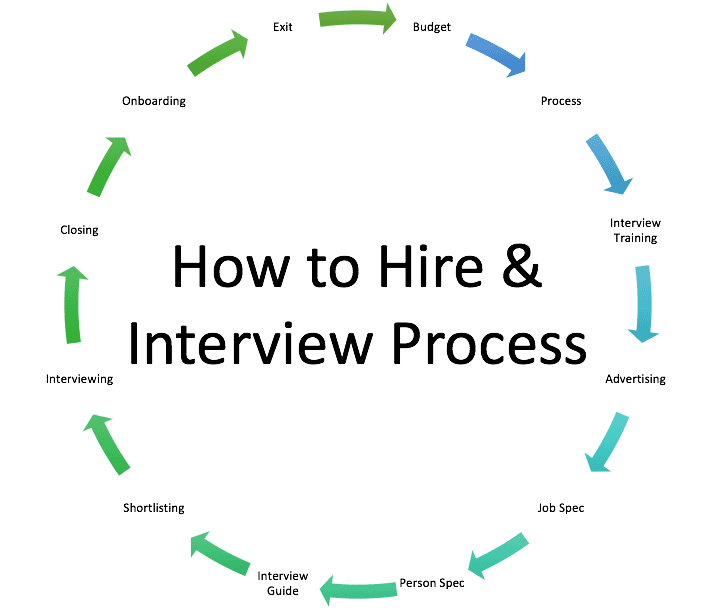The Ultimate Guide on How to Hire and Interview

Great news! Your organisation expanding and you’re tasked to lead a recruitment drive. You’re wondering now how to hire and interview for the best outcome. Naturally, you want to do this as effectively as possible – and you want to do it right.
Because if you don’t, it can be costly, really time-consuming and disastrous for your business on so many levels.
Recruitment Process: How to Conduct an Interview and Hiring Steps

Firstly, here’s a summary of the stages of the recruitment process/lifecycle:
1. Define the recruitment budget and who owns it
2. Define the process. Such as how many screening calls, interviews, reference checking procedures and then follow them
3. Ensure your staff are trained in how to interview
4. Decide if you will advertise directly via your Applicant Tracking System (ATS), or retain Headhunters or recruitment agencies
5. Producing a Job Specification (linked to organisational values). Ensure this spec’s produced with the incumbents and the hiring manager’s involvement – and ensure it’s also realistic
6. Person Spec (linked to key behaviours). Again, if for an existing role, involve whoever’s currently in this function and their direct report
7. Produce Interview Guide. The job and person spec define the interview guide and ensure the right questions about company culture and values are addressed
8. Candidate shortlisting (your Applicant Tracking System can help with collaborative decision-making on your interview shortlist)
9. Interviewing: maximise the data you derive. Make decisions based on data, not just gut feeling. The data from interviewing also feeds future employee objectives, their CPD and PMS/EPE plans etc.
10. Closing. The negotiation and offer process surrounding salary, conditions, Comps and Bens etc.
11. Onboarding and induction. (Again, your ATS can help with this as well)
12. Exit and/or promotion and succession planning
How to Manage Your Recruitment Budget
It’s a simple question, but, who owns the cost of hiring in your organisation? Have you looked at this and calculated the cost to your operations?

Finding and hiring the right people is crucial to the success of every business and can be an expensive exercise, especially when you get it wrong and have to repeat the exercise.
Someone needs to take responsibility for this budget and ensure it’s not an open line item slipping through control.
Also, consider the hidden costs and strain on efficiency and output placed on the rest of an organisation when others have to carry extra responsibilities in between hires and during probation and onboarding periods.
So where are you wasting your budget?
In many organisations, this is a company-wide budget. But in our experience, many places don’t look at this and so the cost of hiring can be expensive – and it’s one area where there’s a lot of money to be saved.
Especially if the cost can be restricted to each manager. You can also choose to incentivise this. For example, at one place I worked with, the cost of the hire was established at 15% of the salary cost. All savings made against this cost were put into the departmental social budget.
More money’s wasted in not focusing on this in organisations than you can imagine. The cost of using a recruiter alone is circa 20% of the person’s starting salary.
The cost of advertising can be extortionate. ATSs can cut thousands off your cost to hire and advertise vacancies.
Candidates and your team will want the process stages mapped out. “Plan the plan then work the plan” is the mantra.
Stick to the plan and everybody will know where they stand and the workflow will be fair, consistent and clear to all involved.
Your communications will need to state what the following stages of the process will/might be. For example, you may decide you will conduct two screening calls per candidate to clear any primary issues to qualify them, followed by first and second/final interviews, plus any relevant referencing, certification checking, medical etc. etc.
Ensure that you have a distinct flow and that the awaiting process is clear and easy to understand.
Is Your Staff Trained in How to Conduct an Interview?
Then there’s interviewing the candidates and making a hiring decision. Hiring is not a right. It’s a learned skill. Use real data derived from your interview guide to judge candidates so that decisions are not made on instinct alone.
If you or your managers aren’t trained in interviewing techniques, then invest and facilitate training for them to develop this skill. Trust me, this will pay dividends immediately.
The best hiring is done through behavioural interviewing related to company culture. ‘Past behaviour is the way to predict future performance’. Hiring on skills alone is inadequate.
You need agile people who are capable of learning, up-skilling and lateral movement. You need the people who say ‘No I don’t how to do that, but I’ll learn how to or find someone that can’.
If you’re worried about someone that ticks all the boxes but the skills, then consider offering them the chance to train or study. I’d wager the delay would be worth it in the long run.
Advertising the Job Position
How do you get job specs in front of the right people? How do you best source valuable applicants’ CVs and attract the right kind of ‘Jedi’ candidates?
Strong Applicant Tracking Systems integrate with major job boards as well as the company marketing mechanisms such as Twitter, Facebook and LinkedIn to get your advertised position in front of the right people.
You also need an automated referral program that not only yields good candidates but gets the employees involved in building the company and cultural buy-in.
Good recruiters can be worth their weight in gold in finding specialised candidates. But you’ll need time to identify these good recruiters. And it’ll take them some time to understand what best fits your organisation.

Not responding to CVs is a poor reflection on a company and can damage the company’s brand. When people send in their CVs, they’re exposing themselves in a vulnerable way, explaining their qualifications, their experiences and their ambitions. The least you can do is acknowledge this with a kind regret letter if you have no role for them. Again, the ATS automation will take care of this for you.
HR professionals are known to treat recruiters with disdain. This is my experience, having worked and networked as a Recruiter, an in-house Recruiter, an HR Manager/Director and now as the CEO of a cloud People-Management Solution.
I don’t think HR professionals generally enjoy being sold to. Yet a good recruiter can make an HR professional look really good.
The Job Specifications
The first document required the job spec. So who should write it?
- The spec should relate to the corporate behaviours and values you’ve established and communicated to your organisation
- You need a successful candidate to buy into and perform to those values so that you can achieve your goals
- Some organisations involve their customers in this process if the person is, or will be customer interfacing
The Person Specifications
The second document required is the person specification. Can you guess who should write this? Yes. You. The hiring manager, incumbent employee, relevant customers and other personnel will interact with the new hire.
- Most important is to hire to the right behaviours you’ve identified that are core to your company culture
- The right characters will enhance output and remain assets, stay longer, be happier and contribute more to the overall effort
- Focusing on skills or qualifications alone will only limit you, slow you down and make you regret not reaching out for the livewires
- You can teach skills but it is a lot more challenging to alter someone’s behaviour
The Interview Guide
You should invest in training your managers on how to interview.

The principles of keeping to the job spec and person spec, related to company behaviours and values will ensure you get to the right shortlist and eliminate candidates that will cost time and money.
- To ensure equality and fairness follow the process and ensure all candidates get asked the same questions
- Make sure you respond to all unsuccessful candidates. This is essential to maintain a good employer brand and actively demonstrate your corporate values and behaviours
- It’s essential that the direct report to the role is the appointed hiring manager
- They must be central to/kept in the loop at all stages of the process
- Preferably he or she will be the one to make the final hiring decision
Shortlisting
Your Applicant Tracking System will help you shortlist your final candidates and compare notes and feedback with your colleagues involved with the process.
Screening and sorting interesting applicants – sticking to your plan by using the spec you distribute and communicate – is much easier with a good end-to-end recruitment management system.
What you want to avoid is strong candidates ‘slipping through the cracks’. An automated system will prevent this and pay for itself time and again with costs slashed by job boards and recruiters.
An ATS also automates communications about successful/unsuccessful applications and next steps etc., which brings us neatly onto.
Interviewing
In order for someone to be hired, every candidate had to first be accepting of these three behaviours:
- Adaptability
- Teamwork
- Customer Focused
Behavioural interviewing techniques should be part of the induction programme for every manager who was hired or promoted.
The most important in the interview is to collect data. And then use it. Use it to match your desired job and person spec, behavioural profiles and values.
Closing
Great news! You’ve followed the process and pinpointed your next superstar. Now it’s time to nail the deal.
Unless the market dynamics of supply and demand are against you, then the spec you produced and the process involved will have made it clear what you’re prepared to offer. Therefore closing should be straightforward and within your budget and wider, stated working conditions advertised.
If you defined and gave ownership of the budget to the hiring manager, then this would’ve been advertised and if the market was not accepting of this then you’d have to review and start again.
If you’ve got the right fit and it’s in the budget, then the job’s been well done.
Whether you choose to deviate from this is up to you. Only you can decide if prima donna requests are within your advertised and actively demonstrated behaviours and values.
Onboarding
A smooth onboarding process allows your new hire to feel welcome, and included and to settle in quickly.
Be sure to use the interview notes as part of induction as the interview was effectively their first appraisal.

These notes start a conversation to understand the strengths and development needs of your newest recruit so you can set meaningful objectives going forward taking their strengths and developmental needs into consideration.
Again, the Applicant Tracking System will help onboarding, seamlessly transferring successful candidates over to the main HR system so that they enter a new set of workflow automation for induction throughout their time in your organisation.
Exit
Once ‘terminated’ you’re obliged to keep records for a certain number of years to meet compliance. A good HR system will allow this. But you should always have good processes in place for succession planning, especially for strong leaders.
Similarly, for sideways/lateral or upward promotions you need to end the flow related to this role and start it again for the next target using the incumbent to optimise the job and person specs and so on and so on.
Plus the best employees also don’t always make the best managers.
Whether you choose to formulate an exit process of interviews etc. is up to you. You should pin this to the behaviours and cultural values from start to finish in my opinion.

